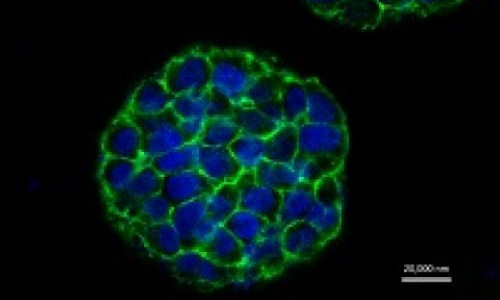A group of researchers in China and the US have successfully created a 3D model of a cancerous tumour using a 3D printer.
The model, which consists of a scaffold of fibrous proteins coated in cervical cancer cells, has provided a realistic 3D representation of a tumour’s environment and could help in the discovery of new drugs and cast new light on how tumours develop, grow and spread throughout the body.
The model consists of a grid structure, 10 mm in width and length, made from gelatin, alginate and fibrin, which recreates the fibrous proteins that make up the extracellular matrix of a tumor. Credit: Image courtesy of Institute of Physics
The grid structure is coated in Hela cells—a unique, ‘immortal’ cell line that was originally derived from a cervical cancer patient in 1951. Due to the cells’ ability to divide indefinitely in laboratory conditions, the cell line has been used in some of the most significant scientific breakthrough studies of the past 50 years.
Although the most effective way of studying tumours is to do so in a clinical trial, ethical and safety limitations make it difficult for these types of studies to be carried out on a wide scale.
To overcome this, 2D models, consisting of a single layer of cells, have been created to mimic the physiological environment of tumours so that different types of drugs can be tested in a realistic way.
With the advent of 3D printing, it is now possible to provide a more realistic representation of the environment surrounding a tumour, which the researchers have demonstrated in this study by comparing results from their 3D model with results from a 2D model.
In addition to testing if the cells remained viable, or alive, after printing, the researchers also examined how the cells proliferated, how they expressed a specific set of proteins, and how resistant they were to anti-cancer drugs.
The proteins studied were part of the MMP protein family. These proteins are used by cancer cells to break through their surrounding matrix and help tumours to spread. Resistance to anti-cancer drugs, which was also studied, is a good indicator of tumour malignancy.
The results revealed that 90 per cent of the cancer cells remained viable after the printing process. The results also showed that the 3D model had more similar characteristics to a tumour compared to 2D models and in the 3D model the cancer cells showed a higher proliferation rate, higher protein expression and higher resistance to anti-cancer drugs.
The lead author of the research, Professor Wei Sun, from Tsinghua University, China, and Drexel University, USA, said: “We have provided a scalable and versatile 3D cancer model that shows a greater resemblance to natural cancer than 2D cultured cancer cells.”
“With further understanding of these 3D models, we can use them to study the development, invasion, metastasis and treatment of cancer using specific cancer cells from patients. We can also use these models to test the efficacy and safety of new cancer treatment therapies and new cancer drugs.”
From Friday 11 April, this paper can be downloaded from http://iopscience.iop.org/1758-5090/6/3/035001/article
Story Source:
The above story is based on materials provided by Institute of Physics.





